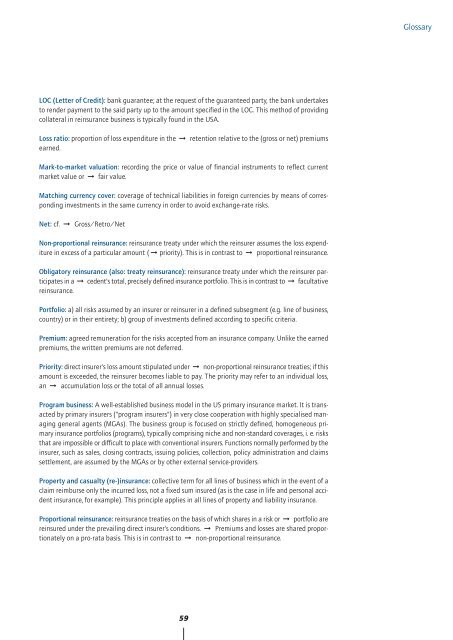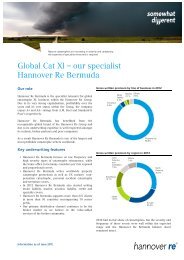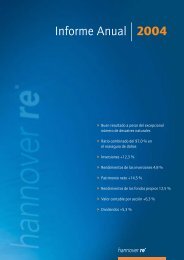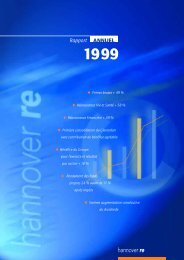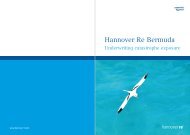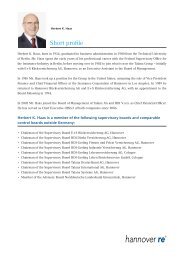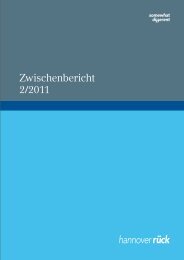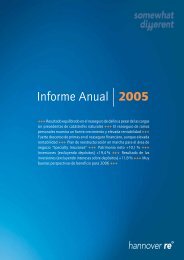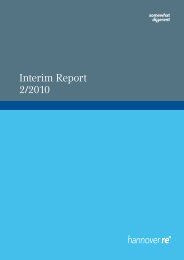Annual Report 2003 - Hannover Re
Annual Report 2003 - Hannover Re
Annual Report 2003 - Hannover Re
Create successful ePaper yourself
Turn your PDF publications into a flip-book with our unique Google optimized e-Paper software.
Glossary<br />
LOC (Letter of Credit): bank guarantee; at the request of the guaranteed party, the bank undertakes<br />
to render payment to the said party up to the amount specified in the LOC. This method of providing<br />
collateral in reinsurance business is typically found in the USA.<br />
Loss ratio: proportion of loss expenditure in the ➞ retention relative to the (gross or net) premiums<br />
earned.<br />
Mark-to-market valuation: recording the price or value of financial instruments to reflect current<br />
market value or ➞ fair value.<br />
Matching currency cover: coverage of technical liabilities in foreign currencies by means of corresponding<br />
investments in the same currency in order to avoid exchange-rate risks.<br />
Net: cf. ➞ Gross/<strong>Re</strong>tro/Net<br />
Non-proportional reinsurance: reinsurance treaty under which the reinsurer assumes the loss expenditure<br />
in excess of a particular amount ( ➞ priority). This is in contrast to ➞ proportional reinsurance.<br />
Obligatory reinsurance (also: treaty reinsurance): reinsurance treaty under which the reinsurer participates<br />
in a ➞ cedent's total, precisely defined insurance portfolio. This is in contrast to ➞ facultative<br />
reinsurance.<br />
Portfolio: a) all risks assumed by an insurer or reinsurer in a defined subsegment (e.g. line of business,<br />
country) or in their entirety; b) group of investments defined according to specific criteria.<br />
Premium: agreed remuneration for the risks accepted from an insurance company. Unlike the earned<br />
premiums, the written premiums are not deferred.<br />
Priority: direct insurer's loss amount stipulated under ➞ non-proportional reinsurance treaties; if this<br />
amount is exceeded, the reinsurer becomes liable to pay. The priority may refer to an individual loss,<br />
an ➞ accumulation loss or the total of all annual losses.<br />
Program business: A well-established business model in the US primary insurance market. It is transacted<br />
by primary insurers ("program insurers") in very close cooperation with highly specialised managing<br />
general agents (MGAs). The business group is focused on strictly defined, homogeneous primary<br />
insurance portfolios (programs), typically comprising niche and non-standard coverages, i. e. risks<br />
that are impossible or difficult to place with conventional insurers. Functions normally performed by the<br />
insurer, such as sales, closing contracts, issuing policies, collection, policy administration and claims<br />
settlement, are assumed by the MGAs or by other external service-providers.<br />
Property and casualty (re-)insurance: collective term for all lines of business which in the event of a<br />
claim reimburse only the incurred loss, not a fixed sum insured (as is the case in life and personal accident<br />
insurance, for example). This principle applies in all lines of property and liability insurance.<br />
Proportional reinsurance: reinsurance treaties on the basis of which shares in a risk or ➞ portfolio are<br />
reinsured under the prevailing direct insurer's conditions. ➞ Premiums and losses are shared proportionately<br />
on a pro-rata basis. This is in contrast to ➞ non-proportional reinsurance.<br />
59


